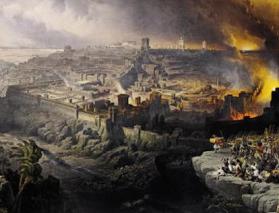The Chronicler’s account of the construction of Solomon’s temple (2 Chronicles 3:1-5:1) follows the creation week of Genesis 1 in general and in specific details.
In general, the account moves from a description of the dimensions, materials and adornments of the three zones of the temple (porch, palace, most holy place, 3:1-9) to a description of the items of furniture that are placed in each room (3:10-4:10). First empty rooms, then the stuff to fill them. This mirrors the movement of Genesis 1 from forming (heaven and earth divided by firmament, earth and sea divided) to filling (lights in firmament, fish in sea, animals and humans on land).
When the Chronicler gets to his “filling” section, he follows the creation account in specific detail and in order:
1) Within the most holy place (corresponding to heaven) he places two cherubim, heavenly beings (3:10-13). Day 1, when “God created heaven and earth.”
2) The veil separates the most holy place from the rest of the temple (3:14). This corresponds to the firmament of Day 2.
3) The bronze altar (4:1) and sea (4:2-6) are earth and sea, corresponding to Day 3.
4) Ten lampstands (4:7) are like the lights placed in the firmament on Day 4.
5) Perhaps the ten tables and one hundred bowls (4:8) correspond to the creation of teeming things on Day 5. As is often the case, the correspondences of Day 5 are the most elusive.
6) Solomon made the court of the priests and the great court, for the new Adamic priests and people (4:9).
7) 2 Chronicles 4:11 says that Huram “finished” (kalah) the work for Solomon, employing a verb first used in Genesis 2:1. Day 7.
Some things in 2 Chronicles 3-4 don’t fit this scheme, most prominently the description of pillars in 3:15-17. Given their placement in the creation-week scheme, they are connectors between the firmament-veil of 3:14 and the bronze earth-altar of 4:1. They are the pillars on which the heavens rest, corresponding conceptually to the twelve oxen who hold up the sea of heavenly water (4:4).
Genesis 1 says nothing about such a structure connecting heaven and earth. Perhaps we are to link the pillars with the altar as part of the earth that is separated from the sea; they represent the “high places” of earth. Or, perhaps we are to infer that the temple represents something new in creation, the establishment of a link of heaven and earth that did not previously exist. From that perspective, we can surmise (as James Jordan has argued) that the pillars are a vertical representation of the temple itself, the capitals corresponding to the most holy place, the bases to the furniture of the court, and the pillars themselves the columns of sacrificial smoke that lead from earth to heaven.
Solomon’s temple would thus not represent old creation, as closely as its construction follows Genesis 1. It represents new creation, the introduction of an innovative element into the world. It’s not incarnation, but it’s a step toward the advent of a human Pillar who unites heaven and earth in His one Person.















